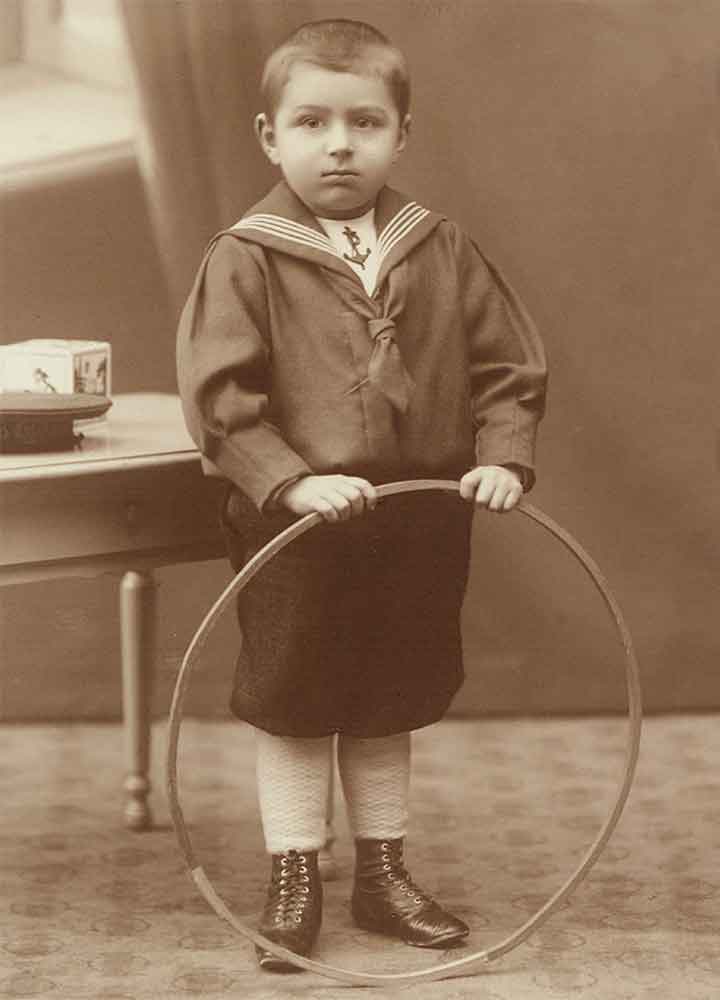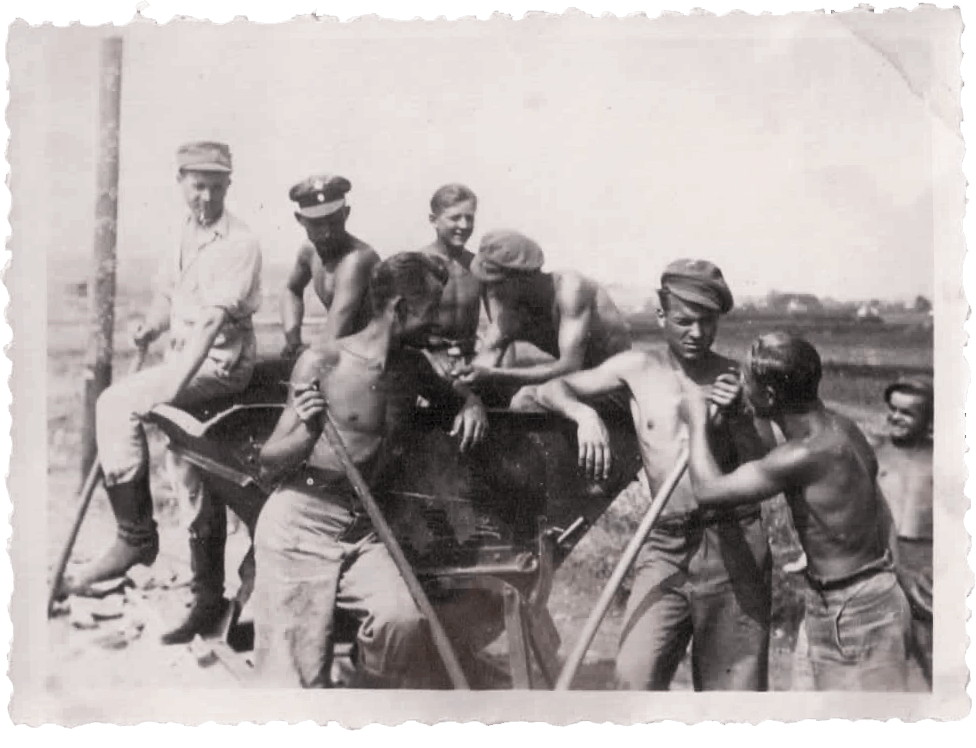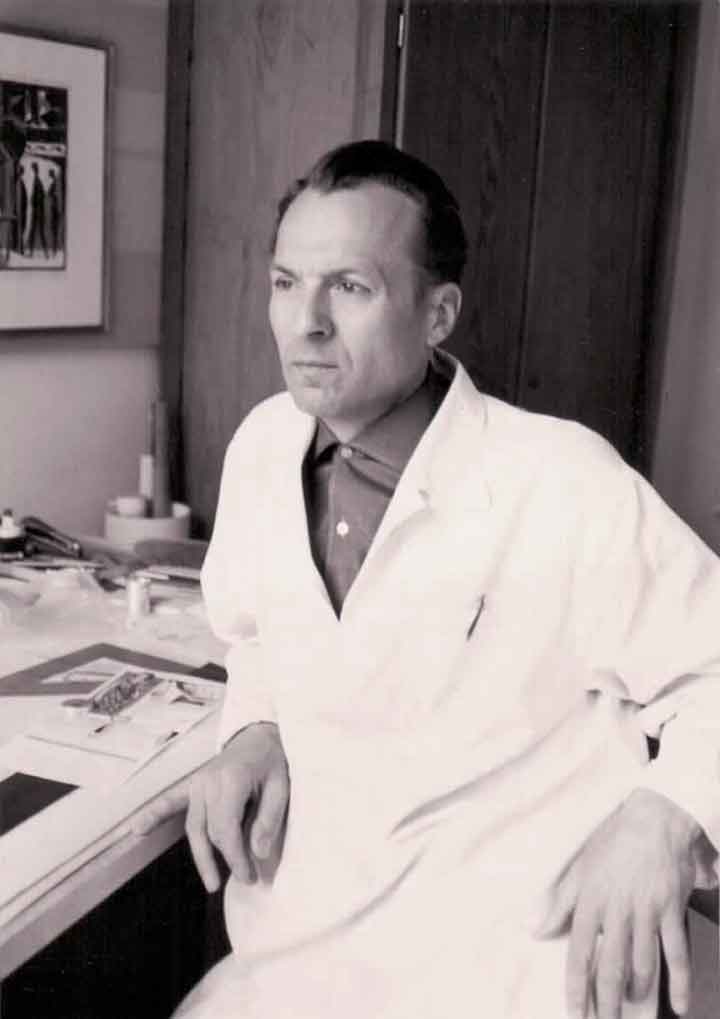Childhood and Youth of the Artist
Friedrich Neubauer was born in 1912 in Nuremberg as the second son of the entrepreneur Friedrich Julius Neubauer and his wife Anna. The company Friedrich Neubauer´s Patent Furniture produced sofas which could be converted into beds, an absolute innovation at that time. Complete home furnishing and decorations, even the re-equipment of the Nuremberg Theater, were carried out. So “Fritz” grew up together with two brothers in an atmosphere of designing and creating new homes as rooms for life and experience, which greatly influenced the choice of his later profession and his artistic works. After finishing high school in Rosenheim Friedrich Neubauer studied architecture at the universities in Munich and Stuttgart.
Painter and Model or "...der Pfui Deifl is scho do"
The remark “...the shameless person is already there” was regularly made by the artist´s mother to announce that the model for the nude studies had arrived. In the middle-class home artistic work of this type was not greatly approved of.
Neubauer, then just twenty years old, is already clearly on his way to Modern Art.
State Labor Service
In 1933 Friedrich Neubauer was mustered in for half a year in the State Labor Service. This Service “with spade and corn” for the community, founded in 1931, was mandatory for male youths. Hard physical work was to have a disciplining effect on the young men. Friedrich Neubauer worked in the street construction near Amberg where he still found time to paint the adjoining little oil painting.
The Artist´s Life in the “Third Reich”
from 1933 to 1945
In the years 1930 to 1932 the artist painted several self portraits, of which two oil paintings have been preserved: “Youthful Self Portrait” and “Self Portrait” (see early works). The latter one of 1931 shows already strong expressionist features.
Interrupted by the State Labor Service Friedrich Neubauer studied architecture at the “Technical Universities” in Munich with Professor Schmitthenner and in Stuttgart with Professor Bonatz from 1932 to 1937. After finishing his studies successfully he was appointed governmental architect already in 1940. As a painter and draftsman the artist was self-taught.
From the time around 1935 “Chair with Walking Stick and Glasses” from 1939, possibly influenced by Matisse and “Field Flowers with Bottle” painted in 1939 have been preserved in the collection. Other works from that time did not survive World War II.

Agnes corresponded to the type of females idealized by the National Socialists. Her tragic fate bothered Friedrich Neubauer even later in his life. The lovely drawings impress the looker-on to this day. The friendly approachable pose, the gaze certainly directed towards the draftsman, holding a posy to her cheek are stirring and touch the mind to this day.
“My bed” Friedrich Neubauer says
Like all men fit for military service Friedrich Neubauer was mustered in for military service where he still occasionally found time to document his recent situation. Unfortunately only few works of that time have been preserved, only the works “Agnes” and “My Bed” of 1941, “Radio Operator” of 1942, and “In the Battle Field” of 1943. The drawing “Dörrersgasse in Nuremberg” shows the view of the historic lane from one of the windows of Friedrich Neubauer´s parental home and also dates back to that time.
Friedrich Neubauer´s professional and artistic career was interrupted by the events of World War II. Due to the restrictions the national socialists imposed on the artists it was not possible to keep up with the international development of the arts. The same is true for the architects and the architecture. The monumental buildings should show that National Socialism was dominant.
In how far Friedrich Neubauer followed this obligation could not be seen from the bequest. All documents were blasted when the parental home was destroyed in the War.
Post War Period
The mammoth task of reconstructing the Old City was lying ahead of the Nuremberg urban planners and architects. The reconstruction of historically outstanding buildings, as for example the Gothic churches, their provisional repair or catching up with the development of modernism were waiting. Friedrich Neubauer was intimately involved with the advisements of City architect Lincke. He was entrusted with the partial reconstruction of one of the most important Nuremberg buildings, the Church of St. Lorenz, especially with the reconstruction of the rose window, the placement of a new organ and the reconstruction of the roof structure of the Gothic High Choir. Among other things the timber work of the roof construction had to be largely replaced. For this immediate measure just freshly cut softwood lumber from the woods surrounding Nuremberg was available. After a heavy storm in 2007 the rafters built in in 1948 were removed because they showed meters long cracks and replaced by more appropriate material.
So enormous was the housing shortage in Nuremberg that compulsory billeting was imposed on the population. That meant Friedrich Neubauer had to move in with his brother´s Hans´s family who on his part lived together with his wife and daughter in just a single room and kitchen in a grand old apartment in a historic residential house in Bahnhofstraße 39. The house had outlasted the war undamaged. The family, who had been bombed out completely, was extremely lucky to be accommodated in this room. In a corner of the room Friedrich Neubauer had his working place which he documented graphically. An arm chair, which had been saved over the war, a shelf and a makeshift desk had to suffice for him to work as an architect.
The Architect Friedrich Neubauer in his Studio
The currency reform and the introduction of the Deutschmark (DM) gave an important impulse for the development of economic and cultural life. Friedrich Neubauer does not only design furniture and catalogues for his brother´s Hans´s company but he also creates the cover sheet for the first catalogue of the professional association of artists after the war in 1948.
He plans the reconstruction of buildings, works as a graphic artist and designer and designs furniture, lamps and ceramic items at the beginning of the fifties. Artists at that time developed a completely new style, in fact the form language of the “fifties”. After exuberantly overloaded historism still persisting after the war furniture now became lighter and more transparent. This kind of development in architecture and interior design had never been seen before in history. The rather scarcely furnished rooms are flooded with light from high windows. The lean furniture makes a feature of light and shadow. That is a new notion of space and indicates the development of a new era.
From 1953 on Friedrich Neubauer can discharge his tasks in his own studio in the business premises, rebuilt in parts, in Lorenzer Straße 5. It was only by the help of the bricks from the destroyed parental home that the building could be reconstructed.
Art and Spac
Apart from the high windows with curtains from the ceiling to the floor the walls for the first time render a colorful background in order to stage the scarce furniture rich in contrast. The objects stay light and mobile. Conscious alignment of form and colors creates the impression of grandeur. The decorations are influenced by artists like Pablo Picasso as the lithography (31 cm x 58 cm) by Friedrich Neubauer shows.
"The theater is always the same! Happy 1958!" the artist says.
Friedrich Neubauer´s studio was a cosmos of its own. There were a big working desk, book shelves and an easel. The walls were all over hung with pictures. Apart from works of his own there were pictures and sculptures he had additionally acquired or exchanged with artist friends. When there was no space on the walls any more he just leaned the pictures to the walls. He slept in a convertible bed surrounded by art. It was here that in 2004 he put the brush down and died.
Exhibitions of Friedrich Neubauer
1932 - 1937 Studies of Architecture at the Technical Universities in Munich and Stuttgart
1971 und 75 International Summer Academy in Salzburg with Commeille/Paris
Masterclass and De Luigi/Venice
Participation in foreign and domestic exhibitions
Gold, Bronze and Silver medals of the Union for Tourism and Culture of the European Post Administration
1948 Frühjahrsausstellung „Berufsverband freier Künstler e.V.“, Fränkische Galerie
21.03. - 25.04.1948 (TN)
1972 Große Kunstausstellung in München (TN)
1973 Raiffeisen-Zentralbank Nürnberg (EA)
1975 Mauthalle Nürnberg, Nürnberger Nachrichten (EA)
1976 „Nürnberger Altstadt“, Raiffeisen-Zentralbank Nürnberg, Juli 1976 (EA)
1978 „Große Schau“ Altstadt, Raiffeisen-Zentralbank Nürnberg
1979 „Ausstellung der 3 V“ (= „3 Vettern“), Galerie Fischer, Minden,
14.01. - 04.02.1979 (TN)
1979 600 Jahre Hallenchor St. Sebald (TN)
1980 Siemens Erlangen,
14.03.- 16.04.1980 (EA)
1982 Große Kunstausstellung München (TN)
1984 Große Kunstausstellung München (TN)
1985 Große Kunstausstellung München (TN)
1985 Raiffeisen-Zentralbank Nürnberg,
24.10. - 30.11.1985 (EA)
1986 Internationale Ausstellung für darstellende Kunst des Post-und Fernmeldewesens,
Rom (TN), Verleihung der Bronze-Medaille der UTC-PTT
1994 „Kunst zum Anfassen“, Wende-Objekte, Kulissen-Bilder, Material-Bilder,
Stadtmuseum Fembohaus, Nürnberg,
Juli - August 1994 (EA)
1996 Wendebilder - Materialbilder - Ölbilder,
Gemeinschaftshaus Langwasser,
14.04. - 11.05 1996 (EA)
2005 Retrospektive des Nürnberger Architekten, Malers und Grafikers Friedrich Neubauer,
Eröffnung der Galerie im Ambiente des Möbelhauses Friedrich Neubauer KG,
12.11.2005
2015 Virtual museum:
museum-nuernberger-kunst.de
























